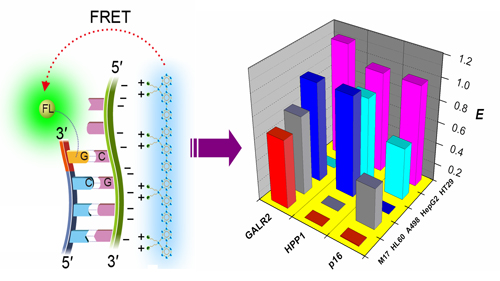ICCAS Develops New Technology for Detection of Disease-Related Genes and Proteins
The development of highly sensitive diagnostic technology for early disease is very important for diseases prevention and control. Conjugated polymers have a good light-harvesting ability and can be used to amplify the fluorescence sensing signal, which provide a new biological sensor model. Funded by National Natural Science Foundation of China, Chinese Academy of Sciences, and Ministry of Science and Technology of China, researchers from Institute of Chemistry, Chinese Academy of Sciences (ICCAS) developed a series of new water-soluble conjugated polymer probes for the identification and detection of disease-related genes and proteins.
DNA methylation is an epigenetic event that plays an essential role in the regulation of gene expression in all mammals. DNA methylation alterations of tumor-linked genes are regarded as a hallmark of early cancers. The researchers have developed a fluorescence resonance energy transfer (FRET)-based and PCR-assisted method for DNA methylation detection using a water-soluble cationic conjugated polymer (CCP). The methylated statuses of p16, HPP1 and GALR2 promoters of five cancer cell lines (HT29, HepG2, A498, HL60 and M17) were assayed to provide an association study between the cancers and susceptibility genes, which provides great potential for early cancer diagnosis. The findings are published in Nature Protocols2010, 5, 1255-1263.
Analysis of loss-of-function phenotypes offers important information for function of protein. Researchers from ICCAS also made use of light-induced protein inactivation and established a new method of inducing its inactivation based on water-soluble conjugated polymer (CPs). The backbone of CPs has lots of light absorb units to impart them high absorption coefficient that is beneficial for reactive oxygen species (ROS) generation that react with and inactivate adjacent proteins. The CPs can form assemblies with proteins by electrostatic or metal ion-mediated coordination interactions to meet the distance requirement for the photoinactivation. The CPs can inactivate protein selectively in a complex enzyme system, which exhibits good specificity. The findings are published in Adv.Mater. 2010, 22, 1602-1606.
The researchers also wrote a review article on water-soluble conjugated polymers. This tutorial review gives an introduction to the field of water-soluble conjugated polymers for biosensor, highlights their synthesis and optical properties and then discusses their applications in DNA, protein and cell detections and cell imaging fields. It is published in Chem. Soc. Rev. 2010, 39, 2411-2419.

Figure 1. Methylation detection analysis of three kinds of gene promoter (p16, HPP1 and GALR2) of HT29, HepG2, A498, HL60 and M17 tumor cells by using conjugated polymer probes.





